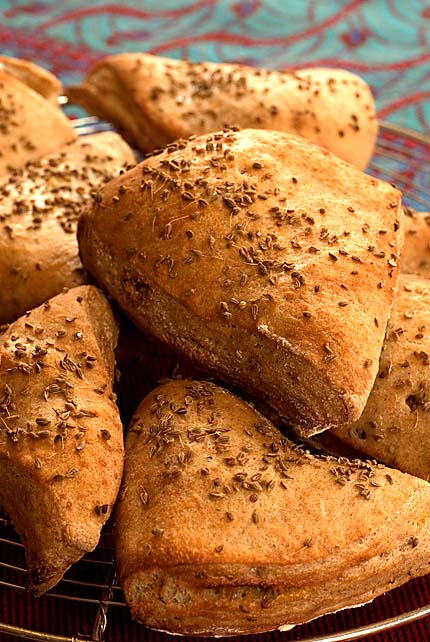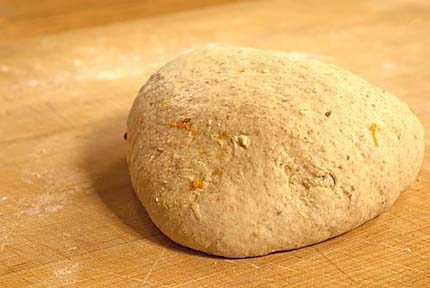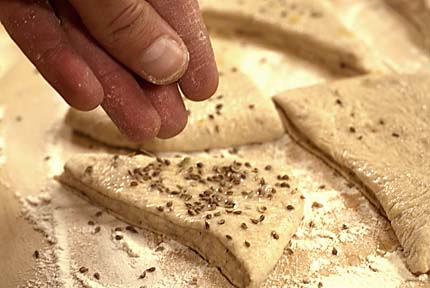Sweet Provençal Flatbread with Anise Seeds

In our first book, we covered the classic European baking tradition, and that meant lots and lots of bread from France, a country where I love to eat anything, but especially bread. Sweet Provencal Flatbread with Anise Seeds is a marvelous example of a bread that is so versatile that it can be split to make great sandwiches today, and then dunked, stale, into strong cafe au lait tomorrow morning. You can mix a whole batch with the sugar, orange zest, and anise seeds, or roll a little of those three into a plain dough to make just a pound’s worth (see end of post).
Twenty minutes before baking time, preheat the oven to 450 degrees F, with a baking stone on the middle rack. Place an empty broiler tray on any other shelf that won’t interfere with rising bread.
Ingredients for a full batch:
2 1/4 cups lukewarm water
1/2 cup orange juice
1/4 cup olive oil
1 1/2 tablespoons granulated yeast (2 packets) (can decrease, see https://artisanbreadinfive.com/?p=85)
1 1/2 tablespoons salt (can decrease, see https://artisanbreadinfive.com/?p=139)
1 tablespoon whole anise seeds for the dough, plus more for topping
1/3 cup sugar
Zest from half an orange, removed with a microzester
6 1/2 cups unbleached all-purpose flour (can swap out 1 to 2 cups whole wheat or rye)
Flour for dusting
Water to paint on top crust
Mix all ingredients together in a bucket or mixing bowl, cover loosely and allow to rest at room temperature for 2 hours. Refrigerate for up to two weeks, removing portions as needed for daily loaves. The wet dough can be used at room temperature but is easier to handle when cold.
Cut off a pound of dough (about the size of a grapefruit) with a kitchen scissors or a serrated knife. Gently form a smooth ball by generously dusting the ball with flour and stretching the surface of the dough around to the bottom on all four sides, rotating the ball a quarter-turn as you go (see videos). You can already see how beautiful the orange zest is going to make the finished breads– the flecks can bee seen already:

Using your hands, a rolling pin, and enough dusting flour to prevent sticking, flatten the ball to a thickness of 1/4-inch. In the book, we specify 1/2-inch, but I wanted to bake these with no resting time so my wife and I could have these flatbreads with lunch today (we ate outside, just like in Provence…). The thinner the flatbread, the less resting time. Like pizza (1/8-inch thick dough), these don’t need to rest after you roll them out.
Keeping your work surface well-dusted with flour, use a pizza cutter to make eight triangular flatbreads, like so:


Using a spatula or your fingers, lift the triangles onto a greased cookie sheet, a silicone mat, or a pizza peel well-dusted with flour or covered with parchment paper:

Use a pastry brush to paint the triangles with water and sprinkle with anise seeds:

Slide them onto the pre-heated baking stone (or place the cookie sheet or silicone pad on the stone). Pour 1 cup of tap water into the broiler tray and quickly close the oven door:

Bake for 15 to 20 minutes, until richly browned and firm. The olive oil keeps this bread soft enough to be split for egg salad sandwiches with farmer’s market Roma tomatoes and carmelized onions:

If you want to start with a plain white batch, cut the sugar, anise, and zest by three-quarters and sprinkle it onto a one-pound piece of dough that has been rolled-out to 1/4-inch thickness. Roll up into a log and re-form into a ball, then roll out again to form triangles. Bake as usual.
Follow us on Twitter, at https://twitter.com/ArtisanBreadIn5
As so many others have stated, I never buy commercially made bread anymore since finding your book and recipes. I prefer to know my ingredients (no preservatives) and have the pride of creating a wonderful loaf all by myself!Thanks so much for opening the magical world of bread baking to”the common man”! Best bread ever, can’t wait to try this.
Hi Vivian,
Thank you for the lovely note, we are so pleased that you are baking so much bread!
Enjoy, Zoë
These look so delicious! I want to sit outside and eat a sandwich made with them for lunch.
My Chef friend Andy Wild (CIA St Helena) told me about your method. Thus far I’ve tried the Classic Boule, the whole wheat and the brioche dough.
Absolutely amazing. I’ve made pizzas, a classic boule loaf, hamburger buns, flat bread, Naan, Caramel Cinnamon rolls and whole wheat loaf. No more store bought bread for me. I’m still waiting for day old bread for croutons, but there never seems to be any.
My whole wheat still needs a little tweaking. I would like it to rise more. I will purchase your recommended King Arthur white whole wheat and see if that resolves. It is still delicious though.
Questions:
I love a good sour dough flavor and I am intrigued by your idea of using less yeast and older dough. When using less yeast, which resting period is longer – the resting period after initially stirring the master together, or the resting period prior to baking – or both?
Also, for sour dough flavor, would it be possible to mix some aged dough with the new batch?
Whole Wheat: If I want to bake a batch of bread immediately after mixing the master, should I just place some in the loaf pan for rising the first couple of hours, or should I wait the couple of hours and then place it in the loaf pan and let it rise again?
Thank you so much for all the wonderful ideas and recipes. The two of you are amazing!
Hi Vera,
In our new book Healthy Bread in Five Minutes a Day we are dedicated to using whole grains (including white whole wheat, spelt and many others) and have figured out several tricks to getting a lighter loaf. We have several recipes that are 100% whole grain and they rise wonderfully and have a more open texture. One of the things that we introduce in our next book is vital wheat gluten, which boosts the protein that gives the bread its ability to stretch and rise. This seems to be essential for whole grain breads that are stored for long periods of time. I think you will find the new book very interesting and tasty! 😉
You can use a sour starter with our method with great results, but as you mentioned the rise time is increased by quite a bit. The initial rise after mixing can be as much as 8-10 hours, if not using any commercial yeast. The second rise is not as profound, but I still find you need to increase it to get an open crumb in the bread.
We have made dough, placed it directly in the loaf pan, allowed it to rise and then baked it, with no second rise. It actually works really well, but it lacks the flavor complexity of waiting 24+ hours.
Have fun playing with all the dough! I’m thrilled that Andy Wild is using the method, or at least talking about it! 🙂
Thanks, Zoë
Thank you Zoe, for all the wonderful info.
I am looking forward to your new, yummy book.
What sour dough starter method or recipe do you recommend?
Andy just had a baby, so who knows if he even has time to eat – ha ha!
Thank you, Vera
Vera: Use about 1 1/2 cups of activated starter, mine is about half water and half flour. Decrease the flour in our recipe by 3/4 cup, and the water by 3/4 cup. Adjust if the consistency is different from our video (see tab above) or if you use a starter with different proportions. You can usually decrease the yeast in our recipe in this situation, but don’t drop it to zero or it becomes unreliable. Jeff
Made this is a boule shape. WONDERFUL!
Nothing left over at the potluck to take home. Gonna try the tri-angle shapes tommorrow for sandwiches for the week-end (and mayber come dunking )
YUM
great bread. Can’t wait for the new book!
Loved it! I baked some flatbreads yesterday and a boule today. I may even try it as pizza dough. Yes, I love anise!
I usually make the oil-free doughs, so I forgot to add the olive oil here. It still came out great and the flatbreads weren’t too dry the next day.
I too forgot the olive oil.
Loved bread (in a boule). Now I’ve tried the flatbreads for sandwich buns. And the “crust” was way too tough.
Don’t know if it was the lack of oil or the ratio of crust to crumb……or my mouth . DH liked it. (but then he said he likes solid bread)
I’ll w/hold judgement (on this recipe for sandwich flatbreads) until I’ve made the correct recipe.
LOVED the taste when made as a boule.
Anne and Helen: OK to leave out the olive oil, but keep in mind that fats are tenderizers and make for the softer crust you may have been looking for. I think you’ll prefer the flats for sandwiches when you leave it in. Pizza will work nicely I think. Jeff
Ooo – this looks yummy . . . why am I surprised? 🙂 Just pre-ordered my copy of HBin5, so I’ll be ticking down days now (15 to release, probably 20 to delivery ’cause I live in ‘the sticks’.) How many of the posts on your blog will actually be part of the new book?
Thanks for everything!
CJ
Hi CJ,
Once the new book is available we will start to do posts based on those recipes. Jeff and I are so excited to start talking about the new recipes!
Enjoy, Zoë
I finally received your Healthy Bread book. I cant wait to purchase vital wheat gluten, in order to get started with what I know will be the best bread ever.
Jessie: Thanks for the kind words. Easiest place to buy VWG if your community stores don’t stock it is Amazon: https://www.amazon.com/Hodgson-Mill-Gluten-Vitamin-6-5-Ounce/dp/B000FDMLVS?&camp=212361&linkCode=wey&tag=arbrinfimiada-20&creative=380725
I wrote yesterday but was not clear with my question. I tasted a Cranberry Orange Brioche and wanted to make my own with your recipe of course. How would I alter your brioche recipe to use orange juice, orange zest and candied peel with dried cranberries. I wasn’t sure you could use oj and let the dough still set for one or two weeks. The bread was good, but I want your version. PLEASE! Thank-you
Hi Suzie,
You can replace up to a 1/3 of the liquid in the dough with OJ, but as you suspected it will decrease its ability to store well. I would not store the brioche made with OJ for more than 5 days or it will become too dense.
Hope that helps! Zoë
i LOVE this recipe and — since i have my dried fruit and citron out for my much anticipated (by me) fruitcake — i’ve added some candied citrus peel. it’s a fabulous addition. thank you again, for such amazing recipes.
Melissa: So glad you like it– anise or other licorice-y seeds like fennel do great in bread, I wish I thought to use them more often. Like everyone else, I fall into a rut and keep making stuff everyone loves over and over. That’s where cookbooks come in– I should use my own! Jeff
Mm… I orderd your book but while i’m waiting for it arrive I decided to try this recipe! Yum!!! This was my first experiment with bread baking! Can’t wait to try more.
2 questions though:
1. As a beginner, I didn’t realize there was a difference between bleached and unbleached flour. When I made the dough yesterday, I realized I used bleached dough. Did I lose something because of this?
2. We’re going on vacation in a few days and I don’t think I’ll be able to use it up before then. Would freezing the dough work? Or should I bake up a bunch of flat breads and freeze those? Is there another option for not wasting the dough?
Thanks so much! Can’t wait to get the book and try more recipes!
Hi Jen,
So glad you enjoyed the bread. Bleached flour has less protein and therefore has less gluten, which gives the bread its structure. This can be fine when making certain flatbreads, but will result in a dough that is too wet to hold its shape well in a free form loaf.
You can either freeze the dough or the baked bread. I prefer to freeze the dough so that when I defrost it and bake it I have fresh bread.
Enjoy your vacation and happy baking! Zoë
Je vous remercie de tout coeur! For me, this is a “do-able” version of my most covetted ‘gibassier’ which before, I’ve only been able to purchase at the Pearl Bakery in Pdx, OR. I immediately made a second batch after the first one presented so beautifully. (Dried tart cherries folded-in nicely in one batch, and was quite complimentary.) Again, thanks from the bottom of my heart!
Ruby
so glad Ruby, thanks!
Wow, made these today and they were a huge hit. Had the first book since it came out and somehow never got around to making these.
Going to try the Moroccan one with the anise barley flour from the second book next.
Thanks for all your baking inspiration.
Hi Mandy,
So glad you are trying all the recipes! Enjoy!
Zoë